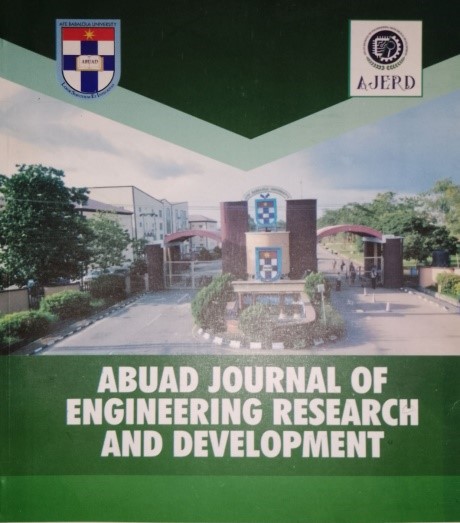Effects of Treated Greywater on Mineral Contents and Proximate Compositions of Pepper Fruits
Main Article Content
Abstract
This study investigates the effects of treated greywater on the mineral and proximate compositions of pepper grown in Akure, Nigeria. Greywater was treated using a filtration system including sand and gravels with common reed, to remove contaminants and reduce potential health risks. The treated greywater was then used to irrigate pepper plants. Minerals and proximate analysis were conducted on the fresh pepper fruits. For 2016, 2017 and 2018 dry seasons, samples from treated greywater irrigation plots showed nitrogen (N) values of 0.37, 0.37, and 0.37 mg/kg, phosphorus values of 0.10, 0.19, and 0.11 mg/kg, and potassium values of 129.00, 130.00, and 128.00 mg/kg, respectively. Samples from plots watered with treated greywater also had 2.30, 2.26, and 2.28% protein, 1.36, 1.41, and 1.38% fat, and 2.00, 3.15, and 3.06% carbohydrates in the dry seasons of 2016, 2017, and 2018, respectively, based on the proximate analysis of hot pepper. These also indicate that irrigation with treated greywater can significantly enhance food supplements needed for human growth and does not affect the quality of pepper for human consumption. Notably, no significant accumulation of heavy metals was detected in the fruits. Continued monitoring and optimized treatment processes are recommended to ensure long-term safety.
Downloads
Article Details

This work is licensed under a Creative Commons Attribution-NonCommercial-ShareAlike 4.0 International License.
References
Al-Hamaiedeh, H. D., & Bino, M. (2010). Effect of treated greywater reuse in irrigation on soil and plants. Desalination, 256(1-3): 115–119. (https://doi.org/10.1016/j.desal.2010.02.004)
Maimon, A., Tal, A., Friedler, E., & Gross, A. (2010). Safe on-site reuse of greywater for irrigation—a critical review of current guidelines. Environmental Science & Technology, 44(9): (https://doi.org/10.1021/es902646g)
Finley, S., Barrington, S., & Lyew, D. (2009). Reuse of domestic greywater for the irrigation of food crops. Water, Air, and Soil Pollution, 199(1): 235–245. (https://doi.org/10.1007/s11270-008-9888-4)
Misra, R. K., Sivongxay, A., & Smith, D. (2010). Impact of greywater irrigation on plant growth and soil properties. Water Practice and Technology, 5(2), wpt2010041, (https://doi.org/10.2166/wpt.2010.041)
Olatunji, T. L., & Afolayan, A. J. (2019). The suitability of wild and cultivated Capsicum species for food and medicinal applications. Plants, 8(1), 31, (https://doi.org/10.3390/plants8010031)
Adeleye, S. A., Ayeni, L. S., & Ojeniyi, S. O. (2014). Effects of organic and NPK fertilizers on soil properties, growth, yield and mineral content of pepper. Journal of Agricultural Science, 6(1): 71–78, (https://doi.org/10.5539/jas.v6n1p71)
Qadir, M., Wichelns, D., Raschid-Sally, L., McCornick, P. G., Drechsel, P., Bahri, A., & Minhas, P. S. (2007). Agricultural use of marginal-quality water—Opportunities and challenges. Advances in Agronomy, 97: 75–144, (https://doi.org/10.1016/S0065-2113%2807%2900003-2)
Alao, F., Olanipekun, A. A., Oloruntade, A. J., Olofintoye, O. O., Oke, A. M., Idusuyi, D. U., Bayode, O., Saka, Q. O. & Ojewole, D. A. (2025). Suitability of Grey-water Treated with Common Reed in Constructed Wetland for Irrigation Purposes in Akure, Nigeria. American Journal of Environment and Climate (AJEC), 4(2): 7 – 14, https://doi.org/10.54536/ajec.v4i2.4503
Ajewole, T. O., Ayesa, A. S., Popoola, K. M., Oluwole, B. R., Aladekoye, D. & Robinson, E. (2022). Effect of effluents (treated and untreated) on the vegetative growth of Amaranthus cruentus L. and Amaranthus hybridus L. Journal of Innovation Science and Technology, 2(1): 120 – 130
Zavadil, J. (2009). The effect of municipal wastewater irrigation on the yield and quality of vegetables and crops. Soil & Water Res., 4(3): 91–103
Rehman, K., Ashraf, S., Rashid, U., Ibrahim, M., Hina, S., Iftikhar, T., & Ramzan, S. (2013). Comparison of proximate and heavy metal contents of vegetables grown with fresh and wastewater. Pak. J. Bot, 45(2): 391-400
Anwar, F., Bhutto, M. A., Riaz, S., & Sitara, U. (2022). Rational sewage water utilization and its impact on the proximate and nutritional quality of cabbage (Brassica oleracea L.). Applied Ecology & Environmental Research, 20(6).
Vanmarcke, H., Tuytschaever, T., Everaert, B., De Cuypere, T. & Sampers, I. (2024). Impact of using stored treated municipal wastewater for irrigation on the microbial quality and safety of vegetable crops. Agricultural Water Management, 297, 108842
Ashfaq, A., Khan, Z. I., Arif, M., Abbas, G., Abbas, T., Gatasheh, M. K., & Shah, A. A. (2024). The proximate composition of vegetables enriched by incorporation of municipal solid waste into fertilizers and its impacts on environment and human health. BMC Plant Biology, 24(1), 887. https://doi.org/10.1186/s12870-024-05581-9
Gorgich, M., Mata, T. M., Martins, A., Caetano, N. S. & Formigo, N. (2020). Application of Domestic Greywater for Irrigating Agricultural Products: A brief study. Energy Reports, 6, 811 - 817.
Du, Z., Zhao, S., She, Y., Zhang, Y., Yuan, J., Rahman, S. U. & Li, P. (2022). Effects of different wastewater irrigation on soil properties and vegetable productivity in the North China Plain. Agriculture, 12(8), 1106. https://doi.org/10.3390/agriculture12081106




